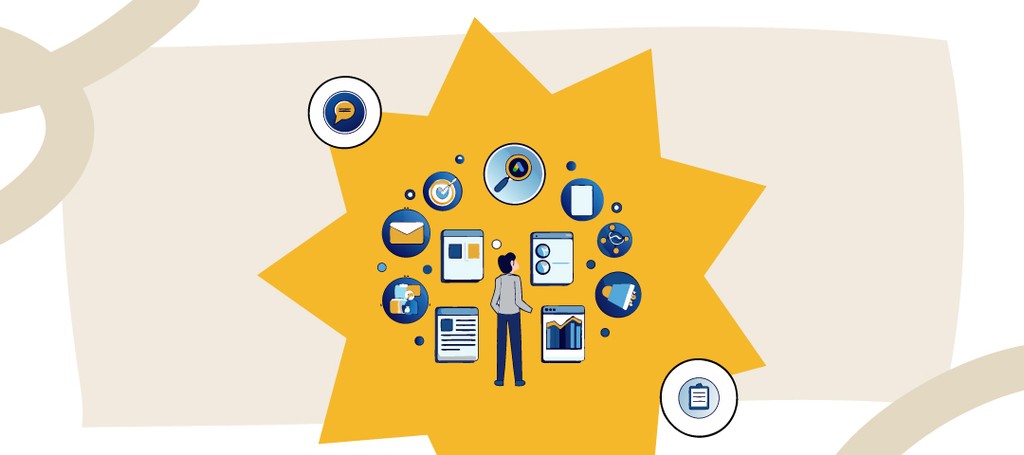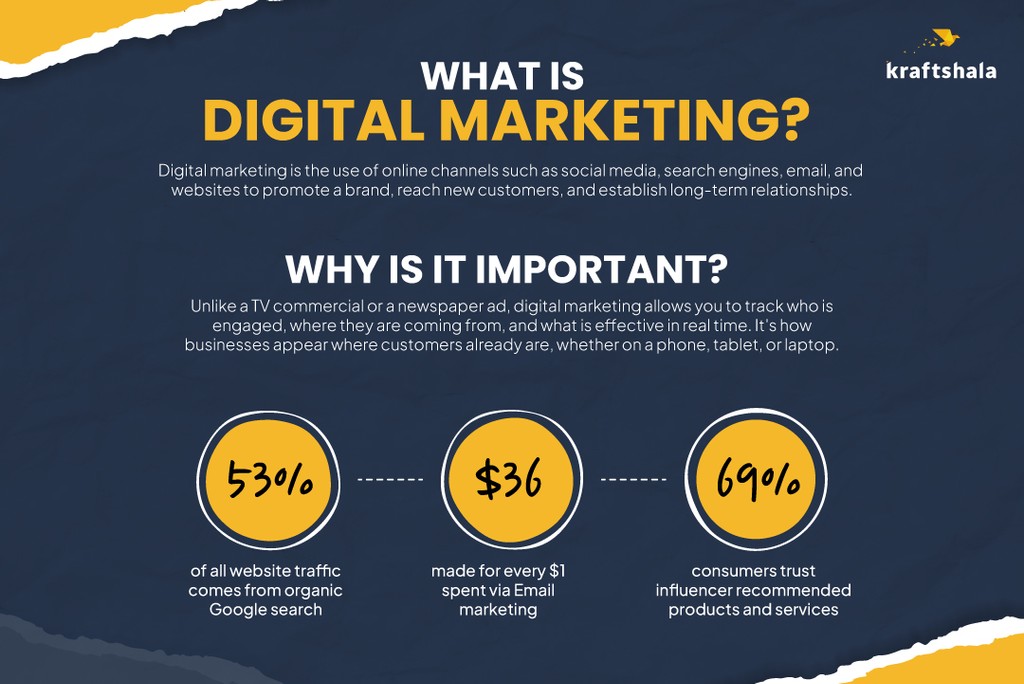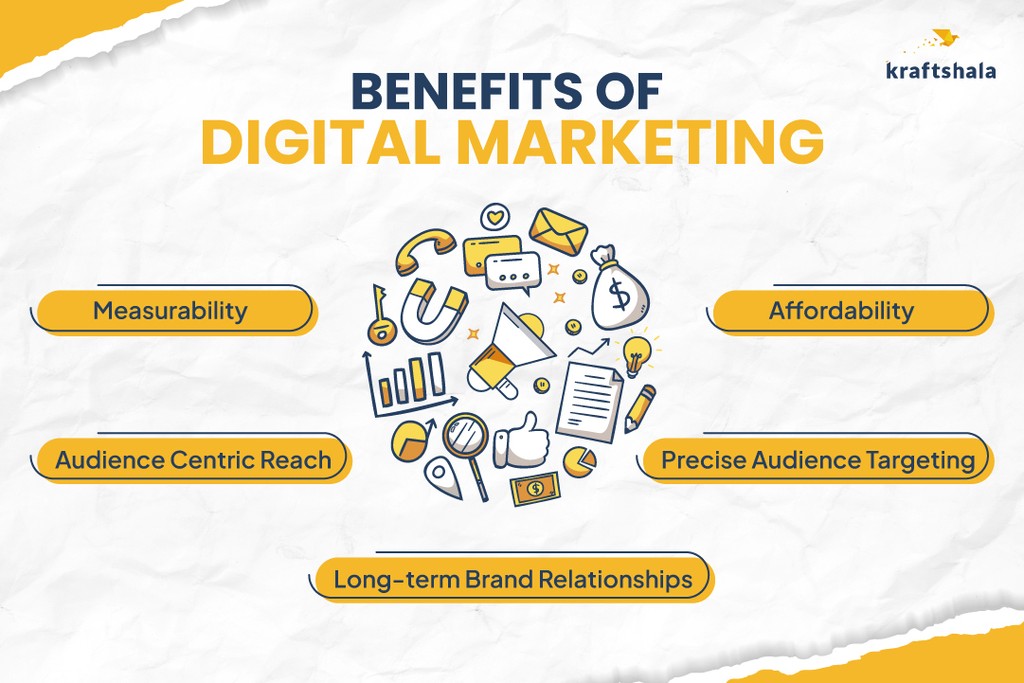What is Digital Marketing? Types, Examples, And Benefits
Table of contents
- What is Digital Marketing?
- How Does Digital Marketing Work?
- Types of Digital Marketing
- The Benefits of Digital Marketing
- Top Tools Used in the Digital Marketing Workflow
- Ready to Begin Your Digital Marketing Journey?
- Frequently Asked Questions (FAQ’s)
You check out a pair of sneakers online. Hours later, you see them again – this time in an Instagram ad. By evening, there’s an email with a discount, nudging you to finally buy. That’s not random. That’s digital marketing in motion.
Digital marketing is defined as the use of online channels such as social media, search engines, email, and websites to promote a brand, reach new customers, and establish long-term relationships. It’s how businesses appear where customers already are, whether on a phone, tablet, or laptop.
Unlike traditional marketing formats like billboards or magazine ads, digital marketing adapts in real time. With nine out of ten U.S. adults going online daily, and 41% online almost constantly, brands can’t afford to sit this one out.
It’s not just about reach, either. According to Forrester, 88% of marketers believe automation and AI are now essential to staying competitive. Digital marketing enables both and more.
Throughout this guide, we’ll break down how digital marketing works, why it matters, and what steps you can take to learn it the right way- including hands-on insights from Kraftshala’s industry-trained professionals.
What is Digital Marketing?
Digital marketing is all about promoting products or services via the internet. It encompasses various strategies that utilize social media, websites, search engines, and email—essentially targeting the areas where consumers are most active.
Simply said, it’s how firms reach their target audience online. Unlike a TV commercial or a newspaper ad, digital marketing allows you to track who is engaged, where they are coming from, and what is effective in real time.
It started with banner ads and basic websites. Now, it’s about creating content people actually want — whether that’s a product demo on Instagram or a helpful blog post that answers a real question. The best digital marketers don’t just push messages; they guide, serve, and adapt based on how people interact online.
Think of a small clothing brand. They post styling tips, respond to DMs, retarget visitors with ads, and send emails when items are back in stock. That’s digital marketing. It’s not static. It moves with people. Now, since this is clear, let’s talk more about what you need to learn about digital marketing.
How Does Digital Marketing Work?
Digital marketing works by guiding a person through a journey — from hearing about a product to becoming a customer and coming back again.
It usually begins with awareness. A brand runs ads or posts content to catch someone’s eye. Then comes consideration, where the audience engages, compares, or reads more. If done right, it leads to a conversion — a sale, sign-up, or download.
But it doesn’t stop there. Brands then focus on retention through emails, loyalty offers, or personalized content. Behind this is a process: identify the audience, build content that speaks to them, launch campaigns, and adjust based on results.
Take Nykaa, for example. They invested heavily in digital campaigns, influencer tie-ups, and product-focused reels across Instagram and YouTube. In just one quarter ending December 2024, their revenue jumped by 27% to ₹2,060 crore, reflecting how well-targeted digital content can directly influence sales.
Cetaphil took a slightly different approach — launching pandemic-era campaigns with a stronger emotional angle. They combined video storytelling, ad targeting, and creator partnerships to reposition themselves. The result? A significant surge in sales, driven by relatable messaging and smart placement.
Types of Digital Marketing
Digital marketing is made up of different strategies, each playing a specific role in how a brand reaches, engages, and converts its audience. Understanding the key digital marketing types gives businesses the chance to show up in the right place, with the right message, at the right time.
Here’s a breakdown of the most widely used types of digital marketing today:
Search Engine Optimization (SEO)
SEO is about helping your website appear when people search for something online. It’s not about tricking Google; rather it’s about making sure your content actually answers the question someone’s typing into the search bar.
Brands use SEO to drive free, ongoing traffic to their site. For example, a nutrition brand writing a blog on “high protein vegan snacks” can rank for that term if it’s optimized well. Over time, that page becomes a reliable traffic source without any paid promotion.
According to industry estimates, over 53% of all website traffic comes from organic search. No wonder companies keep investing in this. From technical fixes to keyword strategy, SEO is a core skill that every digital team values.
As explained in this digital marketing roadmap, SEO is one of the key pillars students build confidence in. They learn how to conduct audits, map keywords, and understand what makes Google rank content better.
Content Marketing and Social Media Marketing
Content marketing entails generating valuable, interesting material that fosters trust. It may be a blog piece, a YouTube video, a free tutorial, or even a meme that explains something well.
Instead of asking for attention, content marketing earns it. Brands that teach, entertain, or solve problems get remembered and followed. Think of Duolingo’s TikToks, or Zomato’s Instagram captions — the content itself becomes the marketing.
More than 70% of B2B marketers say content marketing helps them educate their audience, and 60% report that it builds loyalty. It’s not always about sales right away. It’s about making sure the brand shows up before someone even realizes they need it.
Now, let’s talk about social media marketing. This is where brands meet people — not as customers, but as part of their everyday lives. It’s how companies use platforms like Instagram, LinkedIn, YouTube, and Twitter to build visibility and voice.
A well-timed clip, a related meme, or a behind-the-scenes story can all create interest and conversation. A fashion label, for example, might post styling tips, run product drops through stories, and use polls to shape new collections. It’s not just visibility. It’s participation.
In terms of investment, social media ad spending crossed $270 billion globally in 2023 and continues to grow. However, organic content still plays a major role in brand loyalty and long-term reach.
Performance Marketing
Performance marketing is result-driven. You only pay when someone clicks, signs up, installs, or buys. It’s the core of campaigns where ROI matters from day one.
E-commerce brands often use it to drive conversions quickly. They set up targeted ads on Google, Facebook, or Instagram and track every click or sale. The entire funnel is measurable, from the creative to the landing page.
According to industry trends, nearly 65% of digital ad budgets are now allocated to performance-based models. It allows brands to scale fast while staying in control of cost and results.
Platforms like Google and Meta ads aren’t just about spending — they’re about analyzing and adapting. That kind of hands-on rigor prepares you for real brand work, not just theory.
Affiliate Marketing
Affiliate marketing is based on collaboration. Brands work with individuals or publishers who promote their products and earn a commission on every lead or sale.
Let’s say a tech company teams up with a blogger who reviews gadgets. The blogger shares a unique link, and for every purchase through it, they get a share of the revenue. It’s a cost-effective way to tap into niche communities without running broad ad campaigns.
Affiliate strategies are especially strong in e-commerce, SaaS, and fintech. Globally, this model contributes over 15% of total digital revenue for many companies and continues to scale in regions like India. With more creators and independent voices online, the model is evolving fast.
To understand where affiliates fit into the greater picture, consider the broader scope of digital marketing, particularly in a market where personal recommendations are becoming more important than traditional commercials.
Email Marketing
Email marketing is still one of the most direct ways to reach people. It’s not flashy, but it works — especially when done right.
Whether it’s a newsletter, a product update, or a follow-up offer, emails help brands stay present in people’s lives. An online bookstore might send personalized recommendations based on past purchases, while a travel brand might nudge users with limited-time deals.
Email marketing delivers strong returns. For every $1 spent, it can generate up to $36 in revenue, i.e, 36:1 ROI, making it one of the most cost-effective marketing tools available.
Brands may provide personalized messages based on user preferences and behavior, increasing engagement and conversion rates. People respond to messages that feel like they were written specifically for them.
Influencer Marketing
Influencer marketing taps into personal credibility. Instead of brands speaking for themselves, they partner with creators who already have the trust of their audience.
For instance, a skincare brand might send products to a content creator known for honest reviews. That creator’s Instagram story or YouTube video feels more personal and relatable than a typical ad — and often converts better too.
Influencer marketing isn’t just about reach. It’s about relevance. According to market data, 69% of consumers trust influencer recommendations, compared to just 38% who trust brand-produced content.
For instance, Mamaearth collaborated with top influencers and created content that showcased real use-cases, building both brand recall and trust. It’s that blend of authenticity and exposure that makes influencer marketing a strong digital channel today.
Video Marketing
Video marketing focuses on capturing attention through sight, sound, and motion. It’s not limited to ads — it includes tutorials, explainers, customer stories, or even brand documentaries.
Why does it work? People retain 95% of a message when they view it in a video versus only 10% when reading it in text. That’s why platforms like YouTube, Instagram Reels, and short-form video apps are popular among marketers trying to interact.
Whether it’s a D2C brand showing how a product works or a finance app simplifying money tips, videos get the job done quickly — and memorably.
In a nutshell, video marketing allows you to explain your product or service in a compelling way, and often has higher engagement than text-based formats. That’s what sets it apart — it doesn’t just tell. It shows.
The Benefits of Digital Marketing
Now that we know what digital marketing is and what are its various channels, it’s time to have a quick glance at some digital marketing benefits.
You Can Measure What’s Actually Working
One of the most useful things about digital marketing is that it lets you see what’s happening, right away. You don’t have to guess if something worked — you can track it. Whether it’s website visits, clicks on an ad, email opens, or completed sales, the numbers are all right there, often in real time.
This helps teams understand what’s worth their time and money. If something isn’t working, they can stop it or tweak it. And if something is working, they can double down. That kind of clarity just isn’t possible with most traditional marketing channels.
It Reaches People Where They’re Already Spending Time
People are online almost all the time. They scroll through social media, search for answers, read product reviews, check emails, and watch videos. Digital marketing works by showing up in those exact spaces, at moments when someone might already be interested in what you’re offering.
For example, when someone searches for “easy dinner recipes” and a food brand shows up with a blog post or YouTube video, that content is helpful and not pushy. It feels natural. It’s marketing that fits into someone’s day, not something they skip past.
You Don’t Need a Huge Budget to Start
Digital marketing is often more affordable than people expect. You can begin with a small budget and still reach the right audience; especially if you’re focused and smart about how you run your campaigns.
It’s not about throwing money everywhere. It’s about testing, learning, and adjusting. A small business can start with organic content or targeted ads in just one city and still see results. As the brand grows, the strategy grows too. It’s flexible, and that’s what makes it practical for businesses of all sizes.
It Allows for Precise Audience Targeting
Digital marketing lets you get specific. Want to target 25–35-year-olds in Mumbai who like skincare and shop online? That’s entirely possible.
Most platforms let you build audiences based on age, location, interests, device, buying behavior, and even the time of day they’re most active. This level of targeting not only improves performance but also reduces wasted spend.
It’s not just about reaching more people; rather it’s about reaching the right ones.
Builds Long-Term Brand Relationships
The best digital marketing doesn’t sell. It helps, informs, and engages.
Whether it’s useful blog content, personalized emails, or regular Instagram stories, brands that show up consistently and with value tend to stay top of mind. Over time, this builds trust, and trust leads to loyalty.
People are more likely to buy from a brand they feel connected to. Digital marketing allows you to nurture that connection, not just close a one-time sale.
Top Tools Used in the Digital Marketing Workflow
Digital marketing isn’t just about ideas — it’s also about execution. And to execute well, you need the right tools. Whether you’re running paid campaigns, writing SEO-friendly content, or managing your social calendar, each part of the process relies on technology that helps save time and improve outcomes.
Here’s a breakdown of the most widely used digital marketing tools across key functions and why they matter.
SEO Tools
Google Search Console
This is one of the most important tools for anyone running a website. Google Search Console shows how your site performs in search results — what queries are bringing people in, how your pages are indexed, and where technical issues might be holding you back. It’s free, reliable, and gives you direct feedback from Google itself.
Ahrefs
Ahrefs is used to dig deeper. It helps you understand which keywords to target, what backlinks competitors have, and how your content is ranking over time. It’s especially valuable for content marketers and SEO professionals who need to build long-term traffic.
As explained in this blog on free digital marketing tools, “for someone just starting out, tools like Google Search Console give you the ability to read your site’s performance in a language Google understands.” That makes it one of the best entry points into technical SEO for beginners.
PPC Tools
Google Ads
Google Ads is the go-to platform for search-based campaigns. It allows you to bid on keywords so that your ads appear when someone searches for related terms. The strength of Google Ads lies in its intent — you’re reaching people at the moment they’re actively looking for something.
Meta Ads Manager
Facebook and Instagram ads are managed with this tool. With its advanced targeting features, you may choose who sees your advertisement according to their location, interests, activities, and more.It is extremely graphic and ideal for ads requiring broad reach and engagement.
Both tools offer A/B testing features, conversion tracking, and budget controls, which help marketers learn what works and shift their strategy as needed. Paid ads can burn through a budget fast if not managed properly, so these platforms are designed to be data-rich and responsive.
Social Media Tools
Hootsuite
When a brand is active on multiple platforms, things get messy fast. Hootsuite helps manage that. You can plan posts ahead of time, reply to comments, and keep an eye on mentions all in one place.
It’s especially useful for teams. Say a product team wants to schedule a launch while customer support needs to respond to questions — they can coordinate it all without stepping on each other’s toes. It keeps the brand voice steady, even when five different people are posting.
Buffer
Buffer is simpler – in a good way. It’s built for people who want to plan and post without too much clutter. You load up your content, pick the times, and let it run.
It works well for creators or small businesses that don’t need all the bells and whistles. Just clean scheduling, basic analytics, and enough flexibility to make social media less of a chore.
Email Marketing Tools
Mailchimp
Email might seem old-school, but it still works. Mailchimp helps brands use it in a smarter way. You can set up welcome emails, offer reminders, or send out weekly updates — and then see who actually opened them.
If 2,000 people got your email and only 30 clicked the link, you’ll know. And that helps you change the subject line, rewrite the message, or test something new. It’s not about sending more emails. It’s about sending better ones.
HubSpot
HubSpot isn’t just for email. It also racks how someone moves through your entire site. You can see if someone clicked an email, read a blog, downloaded something, and then came back two days later.
That makes it easier to follow up with the right message. For example, if someone keeps looking at pricing pages but hasn’t signed up yet, you could send them a comparison guide. HubSpot gives you that kind of detail, and then helps you act on it.
Analytics Tools
Google Analytics
Google Analytics is where marketers go to understand how people are actually using a website. It tracks what pages they land on, how long they stay, what they click, and when they leave.
If your blog post is getting views but no one’s clicking the CTA, it’ll show you. If most of your users are on mobile, but your site is glitchy on phones, you’ll catch that too. It doesn’t give answers; it gives clues. The real work is in reading those clues and making decisions from them.
Hotjar
Hotjar adds something different. Instead of just numbers, it shows what people are doing on the screen. With heatmaps and screen recordings, you can watch how users move through a page and track where they get stuck, where they scroll, and where they bounce.
Let’s say people keep missing your sign-up button. Hotjar can help you see why. Maybe it’s buried too far down. Maybe it doesn’t look clickable. This kind of visual feedback often reveals problems that regular data misses.
The reasons to choose digital marketing as a career include the fact that every click, impression, and conversion can be measured and improved, making it a perfect fit for those who enjoy analysing and optimising. That’s what makes analytics so important — it doesn’t just show what happened; it helps you decide what to do next.
Ready to Begin Your Digital Marketing Journey?
Getting started in digital marketing can feel overwhelming. With so many tools, platforms, and strategies, it’s easy to feel stuck before you even begin. What matters most is learning by doing and not just watching tutorials but actually running campaigns, making decisions, and learning from real outcomes.
That’s exactly what the Marketing Launchpad by Kraftshala is built for. It’s a fully immersive program designed to help you build skills, not just collect certificates. You’ll work on real projects, understand how brands grow online, and get the confidence to launch your career.
If you’re serious about digital marketing, this isn’t just a course – it’s your starting point.
Frequently Asked Questions (FAQ’s)
What do digital marketers do?
They figure out how to get the right people to notice a brand online. That could mean writing emails, tweaking a website for search, running Instagram ads, or just understanding why something worked or didn’t.
What are the types of digital marketing?
The main types include search engine optimization (SEO), pay-per-click advertising (PPC), content marketing, email marketing, social media marketing, and affiliate marketing.
How do I begin my digital marketing journey?
Start somewhere — anywhere and actually do things. Don’t just binge tutorials. Try running a basic ad, build a landing page, and write a product description. You’ll learn more from messing up a small project than from reading ten PDFs.
What is a real-world example of digital marketing?
Nykaa used digital campaigns, influencer tie-ups, and platform ads to grow its reach. In one quarter alone, their revenue jumped 27% to ₹2,060 crore, showing how focused online strategies can directly drive business results.
Is digital marketing a good career?
Yes, it’s a strong career choice with growing demand across industries. It offers flexibility to specialize in areas like content, performance, or analytics, and the skills are in high demand for both startups and large companies. With new tools and trends constantly emerging, there’s always room to grow and stay relevant.










